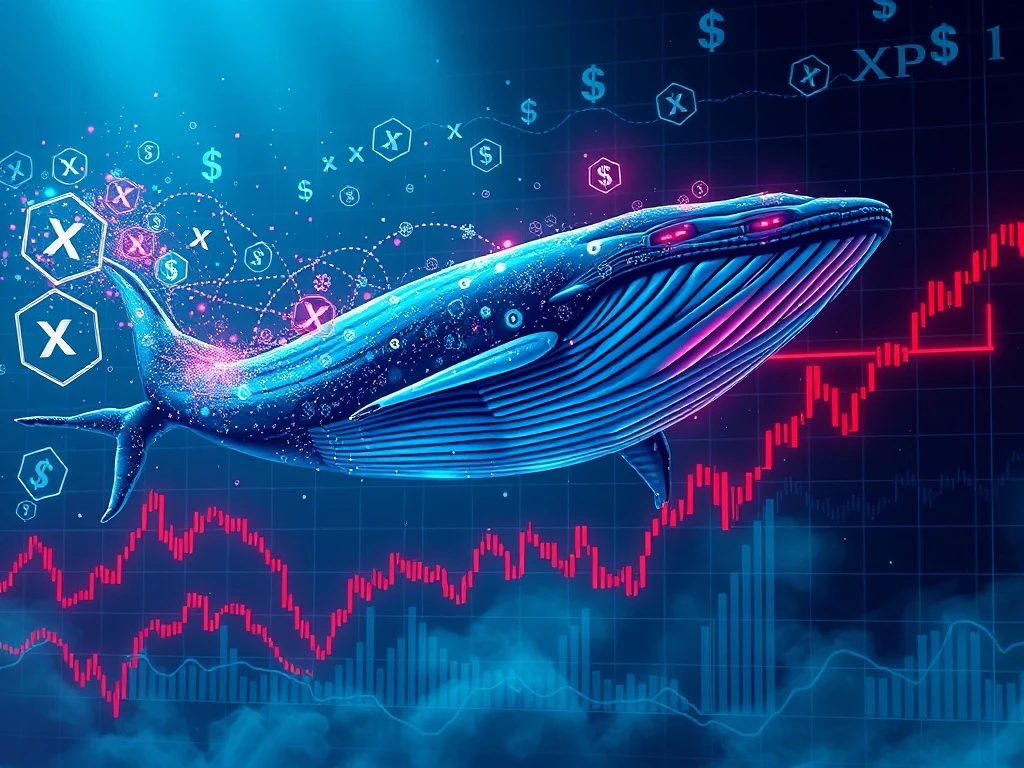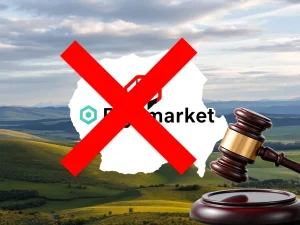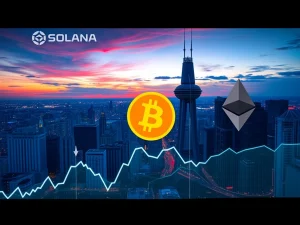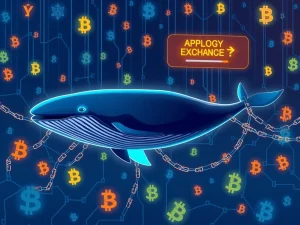XRP Price: Whale’s Daring $16.6M Leveraged Bet Faces Extreme Liquidation Risk

The cryptocurrency world is abuzz with a high-stakes play involving XRP, as a previously dormant whale wallet has suddenly sprung to life, initiating a colossal $16.62 million leveraged long position. This audacious move on the Hyperliquid platform, executed at an average entry price of approximately $3.20 per token, immediately puts the spotlight on the volatile nature of the XRP Price and the sheer confidence (or perhaps, recklessness) of this major player.
The Whale’s Audacious Bet: What’s Driving This Massive XRP Play?
In a surprising development, a whale wallet, previously inactive, has made a significant splash in the market. This entity placed three consecutive limit orders at $3.2029, $3.2051, and $3.2061, ultimately acquiring over 5.17 million XRP tokens. This substantial investment, utilizing 2x isolated leverage, signals a strong bullish conviction in XRP’s near-term prospects, despite the inherent market volatility. The whale also holds a leveraged SOL position, with combined unrealized profits briefly topping $96,000, although the ongoing funding costs have already chipped away over $21,500 from these gains. This strategic entry point for the XRP Price suggests a calculated move to capitalize on potential upward momentum.
Understanding the High-Stakes Leveraged Crypto Game
What exactly does a ‘leveraged position’ mean in the crypto sphere, and why is this particular trade raising eyebrows? In essence, leverage allows traders to control a larger position with a smaller amount of capital. In this case, 2x isolated leverage means the whale is effectively trading with double their initial capital, amplifying both potential gains and losses. While this can lead to substantial profits if the market moves favorably, it dramatically increases the exposure to market downturns. The combined holdings of XRP and SOL illustrate a diversified, albeit highly leveraged, strategy by this XRP Whale, aiming to maximize returns across multiple assets. However, the continuous funding costs associated with such large leveraged positions are a constant drain on profits, highlighting a critical aspect of managing such trades.
The Perilous Liquidation Risk: How Low Can XRP Price Go?
The most critical aspect of this whale’s strategy is the alarming Liquidation Risk. COINOTAG analysis reveals that if XRP’s price drops to approximately $1.64, this entire $16.62 million position will be liquidated. This represents a staggering 50% decline from the whale’s average entry price. This threshold is not just a number; it’s a critical indicator of the trade’s extreme vulnerability. The proximity of this liquidation price underscores the precarious balance between potential gains and catastrophic losses. For the broader crypto market, a sudden drop to this level could trigger further selling pressure, creating a domino effect.
Here’s a quick look at the whale’s position:
- Initial Investment (Estimated): ~$8.31 million (for a $16.62M position with 2x leverage)
- Entry Price (Average): ~$3.20 per XRP
- Number of XRP Tokens: Over 5.17 million
- Liquidation Price: ~$1.64 per XRP
- Percentage Drop to Liquidation: ~50%
- Current Unrealized Profits (XRP + SOL): Over $96,000 (fluctuating)
- Funding Costs Incurred: Over $21,500
Implications for Crypto Market Analysis: What Should Investors Watch For?
The actions of such a large XRP Whale inevitably send ripples through the broader Crypto Market Analysis. The fact that XRP’s price has stabilized just above $3.21, aligning closely with the whale’s average entry point, could reinforce $3.20 as a significant short-term support level. If XRP can hold above this threshold, it might boost broader market sentiment, signaling renewed institutional or high-net-worth interest in the token. Conversely, a sharp decline towards the $1.64 liquidation price would not only wipe out the whale’s position but could also exacerbate downward pressure on XRP’s price, potentially triggering a wider market sell-off.
Traders and investors should closely monitor the XRP Price action around these key levels. The whale’s calculated execution method, initially using limit orders within a narrow range before transitioning to market orders, suggests an attempt to capitalize on micro-fluctuations while securing a substantial position. The current position of XRP near the midpoint of its Bollinger Bands also hints at potential for upward momentum, provided market stabilization persists.
Conclusion: Navigating Volatility with Caution
This dramatic whale move serves as a powerful reminder of the inherent risks and rewards in the volatile cryptocurrency market, especially with leveraged positions. While the whale’s confidence could influence positive sentiment, the looming 50% liquidation risk is a stark warning. It underscores the critical importance of robust risk management strategies for all traders, regardless of their capital size. As the XRP Price continues to fluctuate, all eyes will be on $3.20 as a key support and $1.64 as the ultimate danger zone for this massive, high-stakes bet. Stay vigilant, and remember that even the biggest players face significant challenges in this unpredictable arena.
Frequently Asked Questions (FAQs)
Q1: What is a leveraged position in cryptocurrency trading?
A leveraged position allows a trader to control a larger amount of cryptocurrency with a smaller initial capital. For example, with 2x leverage, a trader can open a $10,000 position with just $5,000 of their own money. While this amplifies potential profits, it also significantly increases the risk of losses and liquidation.
Q2: What does ‘liquidation risk’ mean for a leveraged trade?
Liquidation risk refers to the point at which a trader’s leveraged position is automatically closed by the exchange due to the asset’s price moving against their bet, causing their collateral to fall below a certain maintenance margin. In this XRP Whale’s case, if the XRP Price drops to $1.64, their entire $16.62 million position will be liquidated, meaning they lose their entire initial capital for that trade.
Q3: How does a whale’s trade impact the XRP Price?
Large trades by whales (individuals or entities holding significant amounts of crypto) can significantly influence market sentiment and price action. Their buying can signal bullish confidence, potentially driving prices up, while their selling can trigger fear and downward pressure. This particular XRP Whale’s entry at $3.20 could establish it as a temporary support level, but a liquidation could lead to further price declines.
Q4: What are funding costs in leveraged crypto trading?
Funding costs (or funding rates) are periodic payments exchanged between long and short position holders in perpetual futures contracts to keep the contract price anchored to the spot price. If the funding rate is positive, long position holders (like this whale) pay short position holders, and vice versa. These costs can erode profits, especially for large, long-held leveraged positions.
Q5: Should retail investors follow whale trades?
While observing whale activity can offer insights into market sentiment, retail investors should exercise extreme caution. Whales often have access to more sophisticated tools, information, and capital. Copying their leveraged trades without a deep understanding of risk management and market dynamics can lead to significant losses, especially given the high liquidation risks involved.










